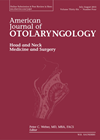
Journal Reviews
Extracapsular dissection alone for low-grade malignancies of the parotid gland – oncologically sound?
The general treatment strategy advocated for a primary carcinoma of the parotid gland is surgical resection +/- adjuvant radiotherapy. A selective neck dissection is usually recommended in all cases of parotid malignancies, except for small, low-grade tumours. In this paper,...
Blood-sampling prognostic predictors for Bell’s palsy
Bell’s palsy is generally defined as an acute-onset unilateral idiopathic mononeuropathy in the facial nerve. It is of unknown aetiology, however, inflammation is considered a major cause. Electroneurography assessing nerve excitability is the most reliable examination for predicting prognosis of...
Does Koos classification predict facial nerve dysfunction?
The Koos classification is a grading system used often for preoperative evaluation of acoustic tumours on imaging studies. It indirectly correlates to the size of the tumour. Size of the vestibular schwannoma is often considered the main determinant for hearing...
Lateral skull base surgery using the endoscope
Endoscopic lateral skull base surgery could be performed via less invasive techniques due to wide panoramic visualisation of the operative field. With less invasive techniques, patients have been shown to require shorter recovery time and reduced postoperative pain. In this...
Efficacy of stereotactic radiosurgery for facial nerve schwannoma
This international multicentre study reviewed the results of stereotactic radiosurgery (SRS) in 63 patients with facial nerve schwannoma over three decades. The facial nerve schwannoma were distinguished from vestibular schwannoma based on intraoperative findings or typical temporal or extra temporal...
Facial nerve anatomy in the temporal bone
Knowledge of the facial nerve anatomy during otological surgery is crucial in avoiding an iatrogenic injury to the facial nerve. In this study, the authors investigated the anatomical relationship between the tympanic portion of the facial canal (FC) and the...
Management of patients with advanced otosclerosis
This paper discusses the management options of advanced otosclerosis. There are several definitions for advanced otosclerosis in the literature but, more recently, the diagnosis of advanced otoscletosis has been reserved for patients who have less than 30% aided speech discrimination...
Righting the paralysed lip
Many surgical procedures that otolaryngologists perform put the facial nerve at risk of injury, a complication that the surgeon and patient fear alike. Unfortunately, injuries to the nerve can and do happen despite adequate precautions, and facial paralysis may be...
3D ultrasonography for evaluation of muscles following facial palsy
Reconstructive surgery for facial nerve palsies is not recommended beyond two to three years after a degenerative facial nerve lesion. Since the time course of muscle atrophy is variable, this timeline is a rough guideline. The only assessment method currently...














